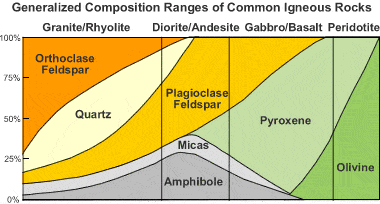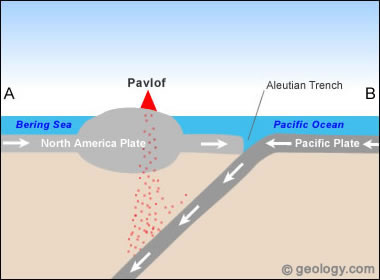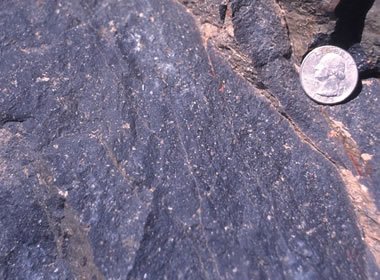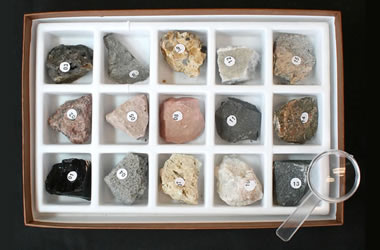Are The Andes Mountains Volcanic

Andesite: The specimen shown is nigh two inches (v centimeters) beyond and has a porphyritic texture.
What is Andesite?
Andesite is the name of a family of fine-grained, extrusive igneous rocks that are usually calorie-free to night gray in color. They have a mineral limerick that is intermediate between granite and basalt. Andesite is a stone typically found in volcanoes above convergent plate boundaries between continental and oceanic plates.

Igneous rock limerick chart: This chart shows that andesite is typically composed of plagioclase, amphiboles, and micas; sometimes with minor amounts of pyroxenes, quartz, or orthoclase.
Tabular array of Contents
An Extrusive Igneous Rock
Andesite is typically establish in lava flows produced by stratovolcanoes above subduction zones. Because these lavas cooled rapidly at the surface, they are mostly composed of small crystals. The mineral grains are usually and then small that they cannot be seen clearly without the use of a manus lens or other magnifying device.
Some specimens that cooled quickly incorporate a meaning amount of drinking glass, while others that formed from gas-charged lavas have a vesicular or amygdaloidal texture.
Mineral Composition
Andesite often weathers to various shades of brown. In the field, weathered specimens must be cleaved to properly see their color and their mineral composition. Classroom specimens usually practise not require breakage.
Andesite is rich in plagioclase feldspar and amphibole minerals. Quartz and pyroxene minerals may exist absent or present in small quantities. Small amounts of mica will be present as biotite or muscovite. Andesite usually does not contain olivine. The accompanying nautical chart titled "Generalized Composition Ranges of Mutual Igneous Rocks" illustrates the mineral composition of andesite.

Stratovolcanoes: Pavlof Volcano (right) and Pavlof Sister Volcano (left) are a pair of symmetrical stratovolcanoes built of andesite flows and tephra on the Alaska Peninsula. Pavlof Volcano is one of the almost agile volcanoes in Alaska. Photograph by T. Miller, United States Geological Survey.
Where Does Andesite Form?
Andesite and diorite are common rocks of the continental chaff above subduction zones. They generally form subsequently an oceanic plate melts during its descent into the subduction zone to produce a source of magma.
Diorite is a coarse-grained igneous rock that forms when the magma remains beneath Earth's surface and cools slowly. Boring cooling facilitates the growth of large mineral crystals in the rock. Andesite is a fine-grained stone that forms when the magma erupts onto the surface and crystallizes quickly.
Andesite and diorite have a composition that is intermediate between basalt and granite. This is because their parent magmas formed from the partial melting of a basaltic oceanic plate. This magma may have received a granitic contribution by melting granitic rocks as it ascended or mixed with granitic magma.

Pavlof Volcano - plate tectonics: Simplified plate tectonics cross-department showing how Pavlof Volcano is located in the Aleutian Island concatenation, above a subduction zone, where basaltic crust of the Pacific Plate is beingness partially melted at depth. The ascending magma then passes through continental chaff of the North America Plate, where it might mix with other magmas or be altered by melting rocks of different composition.
The Geography of Andesite
Andesite derives its proper name from the Andes Mountains of S America. In the Andes it occurs as lava flows interbedded with ash and tuff deposits on the steep flanks of stratovolcanoes. Andesite stratovolcanoes are besides found above subduction zones in Central America, Mexico, Washington, Oregon, the Aleutian Arc of Alaska, Japan, Indonesia, the Philippines, the Caribbean, and New Zealand, among other locations.
Andesite can as well form away from the subduction zone environment. For example, it can form at body of water ridges and oceanic hot spots from fractional melting of basaltic rocks. It can also grade during eruptions at continental plate interiors where deep-source magma melts continental crust or mixes with continental magmas. At that place are many other environments where andesite might form.

Hornblende Andesite Porphyry: A specimen of andesite with large visible hornblende phenocrysts. This blazon of rock could be called an "andesite porphyry" considering of its texture. It could also be chosen a "hornblende andesite" considering of its composition. Photo past NASA.
Andesite Porphyry
Occasionally, andesites comprise large, visible grains of plagioclase, amphibole, or pyroxene. These large crystals are known equally "phenocrysts." They begin forming when a magma, which is cooling at depth, approaches the crystallization temperature of some of its minerals. These high-crystallization-temperature minerals begin forming below the surface and grow to visible sizes before the magma erupts.
When the magma erupts onto the World's surface, the rest of the melt crystallizes quickly. This produces a rock with two dissimilar crystal sizes: large crystals that formed slowly at depth (the "phenocrysts"), and small crystals that formed quickly at the surface (known as "groundmass").
"Andesite porphyry" is the proper noun used for these rocks with two crystal sizes. The name of an arable phenocryst mineral may be used as an describing word to the rock name. An example is the hornblende andesite porphyry shown in the accompanying photograph.

Andesite outcrop: Close view of an andesite lava catamenia at Brokeoff Volcano in California. Photo past the United States Geological Survey.

Stone & Mineral Kits: Go a rock, mineral, or fossil kit to learn more about Earth materials. The best fashion to learn nigh rocks is to have specimens available for testing and examination.
Dissolved Gas and Explosive Eruptions
Some magmas that produce explosive eruptions above subduction zones comprise enormous amounts of dissolved gas. These magmas tin comprise several pct dissolved gas by weight! This gas can take several origins, examples of which include the following:
- Water vapor produced when ocean-floor sediments on an oceanic plate are heated in a subduction zone.
- Water vapor produced when hydrous minerals dehydrate in the heat of a subduction zone.
- Carbon dioxide produced when rise magma encounters carbonate rocks, such equally limestone, marble, or dolomite.
- Water vapor produced when a rising magma chamber encounters groundwater.
At depth, these gases can be dissolved in the magma similar carbon dioxide dissolved in a can of common cold beer. If that can of beer is shaken and suddenly depressurized by opening the tin can, the gas and the beer will erupt from the opening.
A volcano behaves in a similar manner. A rising magma bedchamber tin instantly exist depressurized past a landslide, faulting, or other event and an enormous volume of chop-chop expanding gas will explode through the overlying stone.
Many volcanic plumes and ash eruptions occur when gas-charged andesitic magmas erupt. The gas pressure level that causes the eruption blows large amounts of tiny rock and magma particles into the atmosphere.
These particles, known as volcanic ash, tin can be diddled high into the atmosphere and carried long distances by the wind. They often crusade problems for aircraft operating downwind from the volcano.
Catastrophic eruptions like Mount St. Helens, Pinatubo, Redoubt, and Novarupta were produced by andesitic magmas with enormous amounts of dissolved gas nether high force per unit area. Information technology is difficult to imagine how a magma can contain enough dissolved gas to produce i of these eruptions. Magma is World'south well-nigh powerful solvent.

Andesite Flow: 1 of numerous massive andesite flows from the Zarembo Isle area of southeastern Alaska. They are gray pyroxene and feldspar porphyrys that weather to maroon or light-green. Photo by USGS.
The Elusive Definition of Andesite
The formal definition of andesite is problematic. Many authors have classified igneous rocks based upon their chemical and mineralogical compositions. Nevertheless, none of these classifications are in perfect agreement.
For a fine-grained rock like andesite, these classifications are impossible to utilize precisely when in the field or the classroom. They require chemical or mineralogical analyses that are usually non available, affordable, or practical.
If you examine a rock that appears to be andesite, only you are not confident that it meets the mineralogical or chemical nomenclature of andesite, y'all might properly call it an "andesitoid" stone. What does that hateful? It ways that the rock looks like andesite, simply, a microscopic test or chemical analysis might prove you incorrect!
Find Other Topics on Geology.com:
 Rocks: Galleries of igneous, sedimentary and metamorphic stone photos with descriptions. |  Minerals: Information near ore minerals, gem materials and rock-forming minerals. |
 Volcanoes: Articles about volcanoes, volcanic hazards and eruptions past and present. |  Gemstones: Colorful images and articles about diamonds and colored stones. |
 General Geology: Manufactures about geysers, maars, deltas, rifts, table salt domes, water, and much more! |  Geology Store: Hammers, field bags, hand lenses, maps, books, hardness picks, gold pans. |
 |  Diamonds: Learn about the properties of diamond, its many uses, and diamond discoveries. |
Are The Andes Mountains Volcanic,
Source: https://geology.com/rocks/andesite.shtml
Posted by: ogdenalling.blogspot.com


0 Response to "Are The Andes Mountains Volcanic"
Post a Comment